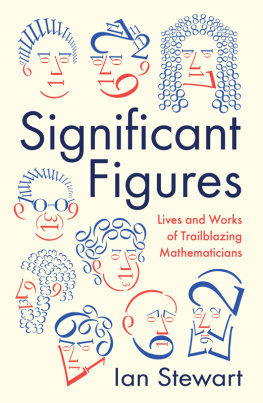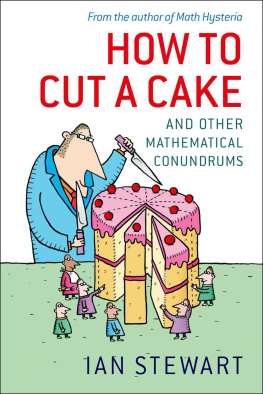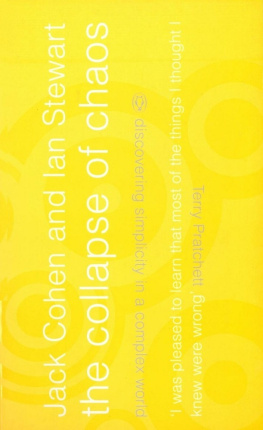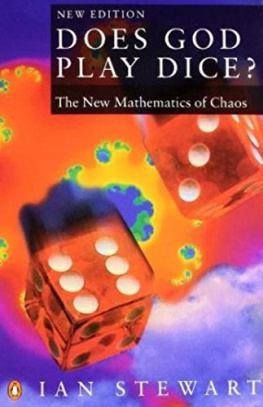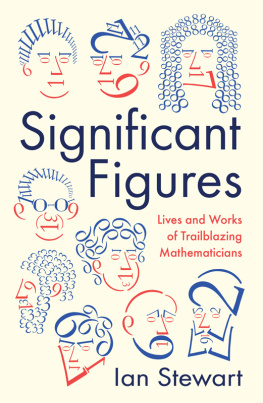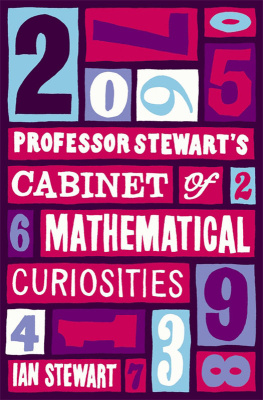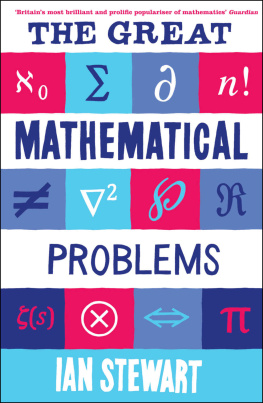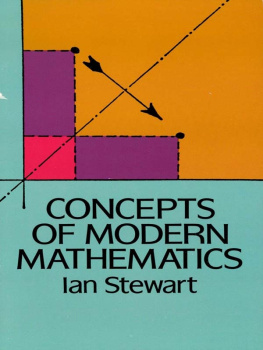Ian Stewart - Significant Figures: Lives and Works of Trailblazing Mathematicians
Here you can read online Ian Stewart - Significant Figures: Lives and Works of Trailblazing Mathematicians full text of the book (entire story) in english for free. Download pdf and epub, get meaning, cover and reviews about this ebook. year: 2017, publisher: Profile Books Ltd, genre: Romance novel. Description of the work, (preface) as well as reviews are available. Best literature library LitArk.com created for fans of good reading and offers a wide selection of genres:
Romance novel
Science fiction
Adventure
Detective
Science
History
Home and family
Prose
Art
Politics
Computer
Non-fiction
Religion
Business
Children
Humor
Choose a favorite category and find really read worthwhile books. Enjoy immersion in the world of imagination, feel the emotions of the characters or learn something new for yourself, make an fascinating discovery.
- Book:Significant Figures: Lives and Works of Trailblazing Mathematicians
- Author:
- Publisher:Profile Books Ltd
- Genre:
- Year:2017
- Rating:4 / 5
- Favourites:Add to favourites
- Your mark:
- 80
- 1
- 2
- 3
- 4
- 5
Significant Figures: Lives and Works of Trailblazing Mathematicians: summary, description and annotation
We offer to read an annotation, description, summary or preface (depends on what the author of the book "Significant Figures: Lives and Works of Trailblazing Mathematicians" wrote himself). If you haven't found the necessary information about the book — write in the comments, we will try to find it.
Significant Figures: Lives and Works of Trailblazing Mathematicians — read online for free the complete book (whole text) full work
Below is the text of the book, divided by pages. System saving the place of the last page read, allows you to conveniently read the book "Significant Figures: Lives and Works of Trailblazing Mathematicians" online for free, without having to search again every time where you left off. Put a bookmark, and you can go to the page where you finished reading at any time.
Font size:
Interval:
Bookmark:
Significant Figures
Ian Stewart is Mathematics Professor Emeritus at the University of Warwick. His recent books include Incredible Numbers, Seventeen Equations that Changed the World, Professor Stewarts Casebook of Mathematical Mysteries and Calculating the Cosmos (all published by Profile). He is a Fellow of the Royal Society.
By the same author
Concepts of Modern Mathematics
Does God Play Dice?
Fearful Symmetry (with Martin Golubitsky)
Game, Set, and Math
Another Fine Math Youve Got Me Into
Natures Numbers
From Here to Infinity
The Magical Maze
Lifes Other Secret
Flatterland
What Shape is a Snowflake? (revised edition: The Beauty of Numbers in Nature)
The Annotated Flatland
Math Hysteria
The Mayor of Uglyvilles Dilemma
How to Cut a Cake
Letters to a Young Mathematician
Taming the Infinite (alternative title: The Story Of Mathematics)
Why Beauty is Truth
Cows in the Maze
Professor Stewarts Cabinet of Mathematical Curiosities
Mathematics of Life
Professor Stewarts Hoard of Mathematical Treasures
Seventeen Equations that Changed the World (alternative title: In Pursuit of the Unknown)
The Great Mathematical Problems (alternative title: Visions of Infinity)
Symmetry: a Very Short Introduction
Jack of All Trades (science fiction eBook)
Professor Stewarts Casebook of Mathematical Mysteries
Professor Stewarts Incredible Numbers
Calculating the Cosmos
Infinity: a Very Short Introduction
With Jack Cohen
The Collapse Of Chaos
Evolving the Alien (alternative title: What Does A Martian Look Like?)
Figments of Reality
Wheelers (science fiction)
Heaven (science fiction)
Science Of Discworld series (with Terry Pratchett and Jack Cohen)
The Science of Discworld
The Science of Discworld II: The Globe
The Science of Discworld III: Darwins Watch
The Science of Discworld IV: Judgement Day
With Tim Poston
The Living Labyrinth (science fiction)
Rock Star (science fiction)
iPad app
Incredible Numbers
Significant Figures
Lives and Works of Trailblazing Mathematicians
Ian Stewart

First published in Great Britain in 2017 by
PROFILE BOOKS LTD
3 Holford Yard
Bevin Way
London
WC1X 9HD
www.profilebooks.com
Copyright Joat Enterprises, 2017
The right of Ian Stewart to be identified as the author of this work has been asserted by his estate in accordance with the Copyright, Designs and Patents Act 1988.
All rights reserved. Without limiting the rights under copyright reserved above, no part of this publication may be reproduced, stored or introduced into a retrieval system, or transmitted, in any form or by any means (electronic, mechanical, photocopying, recording or otherwise), without the prior written permission of both the copyright owner and the publisher of this book.
A CIP catalogue record for this book is available from the British Library.
eISBN 978 178283 149 5
The paper this book is printed on is certified by the # 1996 Forest Stewardship Council A. C. (FSC). It is ancient-forest friendly. The printer holds FSC chain of custody SGS-COC-2061.
To John Davey, editor and friend
(19 April 194521 April 2017)
Introduction
ALL BRANCHES OF SCIENCE can trace their origins far back into the mists of history, but in most subjects the history is qualified by we now know this was wrong or this was along the right lines, but todays view is different. For example, the Greek philosopher Aristotle thought that a trotting horse can never be entirely off the ground, which Eadweard Muybridge disproved in 1878 using a line of cameras linked to tripwires. Aristotles theories of motion were completely overturned by Galileo Galilei and Isaac Newton, and his theories of the mind bear no useful relation to modern neuroscience and psychology.
Mathematics is different. It endures. When the ancient Babylonians worked out how to solve quadratic equations probably around 2000 BC, although the earliest tangible evidence dates from 1500 BC their result never became obsolete. It was correct, and they knew why. Its still correct today. We express the result symbolically, but the reasoning is identical. Theres an unbroken line of mathematical thought that goes all the way back from tomorrow to Babylon. When Archimedes worked out the volume of a sphere, he didnt use algebraic symbols, and he didnt think of a specific number as we now do. He expressed the result geometrically, in terms of proportions, as was Greek practice then. Nevertheless, his answer is instantly recognisable as being equivalent to todays 4/3r3.
To be sure, a few ancient discoveries outside mathematics have been similarly long-lived. Archimedess Principle that an object displaces its own weight of liquid is one, and his law of the lever is another. Some parts of Greek physics and engineering live on too. But in those subjects, longevity is the exception, whereas in mathematics its closer to the rule. Euclids Elements, laying out a logical basis for geometry, still repays close examination. Its theorems remain true, and many remain useful. In mathematics, we move on, but we dont discard our history.
Before you all start to think that mathematics is burying its head in the past, I need to point out two things. One is that the perceived importance of a method or a theorem can change. Entire areas of mathematics have gone out of fashion, or become obsolete as the frontiers shifted or new techniques took over. But theyre still true, and from time to time an obsolete area has undergone a revival, usually because of a newly discovered connection with another area, a new application, or a breakthrough in methodology. The second is that as mathematicians have developed their subject, theyve not only moved on; theyve also devised a gigantic amount of new, important beautiful, and useful mathematics.
That said, the basic point remains unchallenged: once a mathematical theorem has been correctly proved, it becomes something that we can build on forever. Even though our concept of proof has tightened up considerably since Euclids day, to get rid of unstated assumptions, we can fill in what we now see as gaps, and the results still stand.

Significant Figures investigates the almost mystical process that brings new mathematics into being. Mathematics doesnt arise in a vacuum: its created by people. Among them are some with astonishing originality and clarity of mind, the people we associate with great breakthroughs the pioneers, the trailblazers, the significant figures. Historians rightly explain that the work of the greats depended on a vast supporting cast, contributing tiny bits and pieces to the overall puzzle. Important or fruitful questions can be stated by relative unknowns; major ideas can be dimly perceived by people who lack the technical ability to turn them into powerful new methods and viewpoints. Newton remarked that he stood on the shoulders of giants. He was to some extent being sarcastic; several of those giants (notably Robert Hooke) were complaining that Newton was not so much standing on their shoulders as treading on their toes, by not giving them fair credit, or by taking the credit in public despite citing their contributions in his writings. However, Newton spoke truly: his great syntheses of motion, gravity, and light depended on a huge number of insights from his intellectual predecessors. Nor were they exclusively giants. Ordinary people played a significant part too.
Next pageFont size:
Interval:
Bookmark:
Similar books «Significant Figures: Lives and Works of Trailblazing Mathematicians»
Look at similar books to Significant Figures: Lives and Works of Trailblazing Mathematicians. We have selected literature similar in name and meaning in the hope of providing readers with more options to find new, interesting, not yet read works.
Discussion, reviews of the book Significant Figures: Lives and Works of Trailblazing Mathematicians and just readers' own opinions. Leave your comments, write what you think about the work, its meaning or the main characters. Specify what exactly you liked and what you didn't like, and why you think so.

